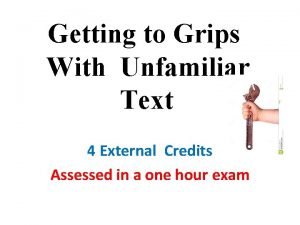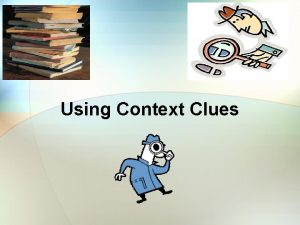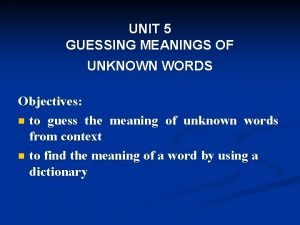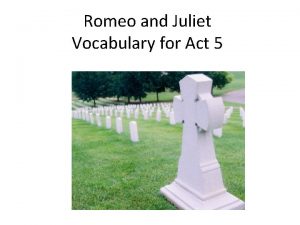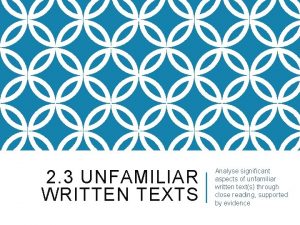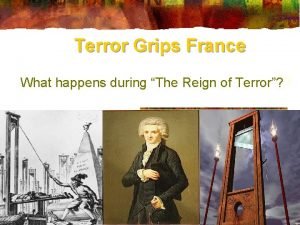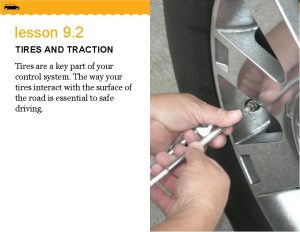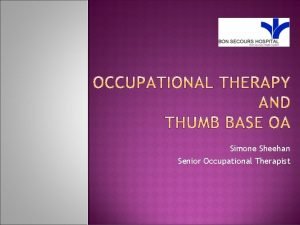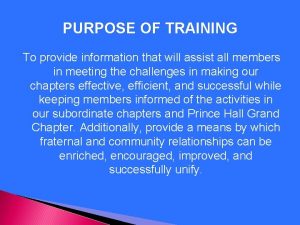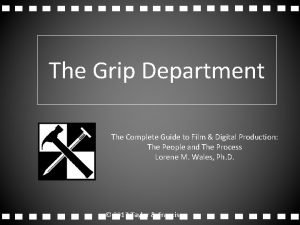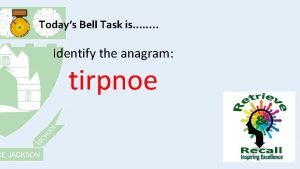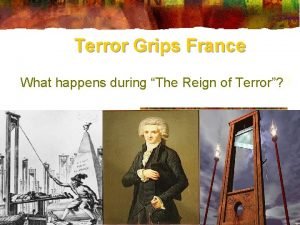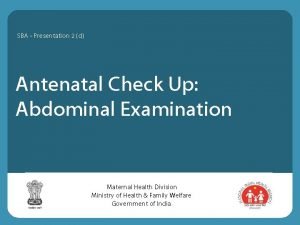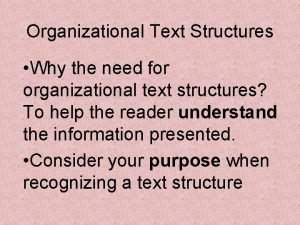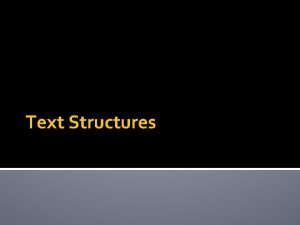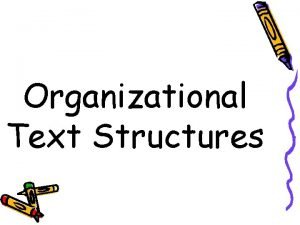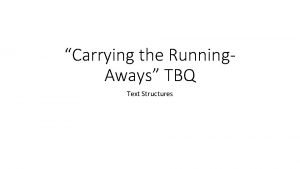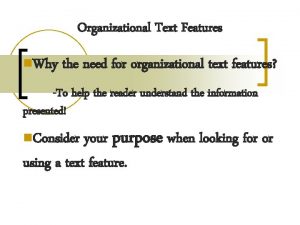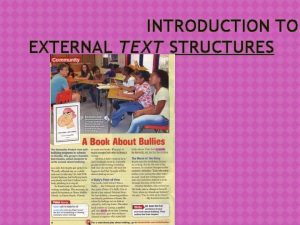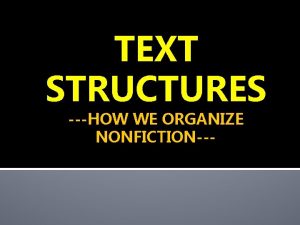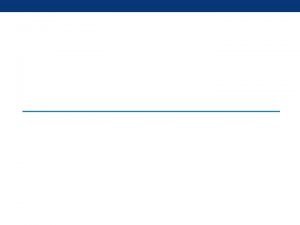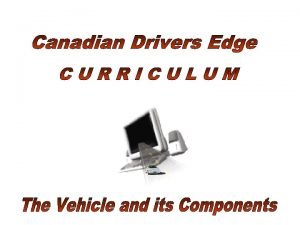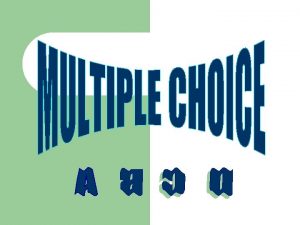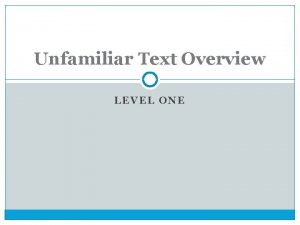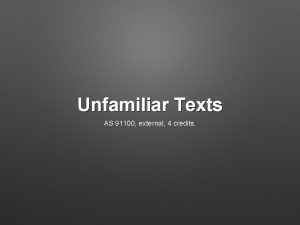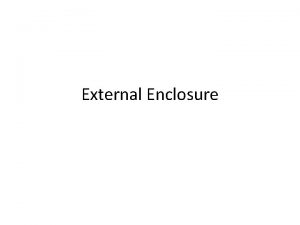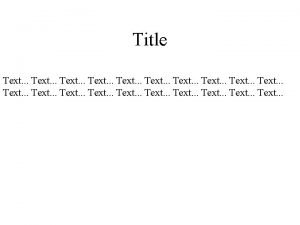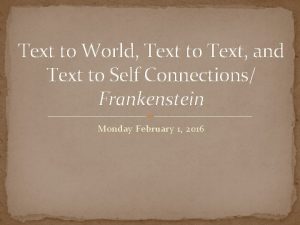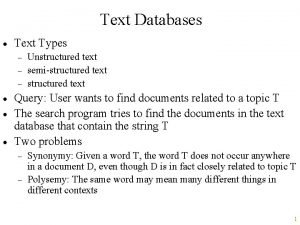Getting to Grips With Unfamiliar Text 4 External


























- Slides: 26

Getting to Grips With Unfamiliar Text 4 External Credits Assessed in a one hour exam

This Means Close Reading

To Find • Meanings • Methods

Close Reading Counts

Question Format You are given 3 texts in a booklet to read very closely. Usually they include: * a fiction extract * a poem * non-fiction extract In a second booklet you are given questions on each text in which you write an answer in short essay form.

Study th. IS Example • Text A: Column /Opinion • Notice the heading clue, the text title and author, the paragraph layout and the source information given at the bottom. • Read it through twice and then in groups carry out a SPLATT analysis

S. P. L. A. T. T! Subject – what is the text about? Purpose – what is the writer’s intention or purpose in the text? (To inform? To persuade? To entertain? ) Language – which techniques are being used, why? Audience – who is it aimed at? How can you tell? Tone – what is the writer’s attitude to the topic? Theme – what is the main idea / message?

Glossary Word: Tone is the writer’s attitude toward the subject being written about and toward the audience implied in a text. e. g. the tone of a text could be formal, intimate, solemn, sombre, playful, serious, ironic, condescending, or many other possible attitudes.

After SPLATT… • Look at the essay instruction for more guides to understanding (copy from next slide) • Make a list of the separate ideas /meanings in it about the topic which the writer is sharing. • Make a list of the language methods he/she is using to communicate his/her ideas.

Exam Design e. g. Question One: Column / Opinion Refer to Text A in the resource booklet to answer this question. First the examiner gives you a helpful overview e. g. The writer uses humour to suggest ways that text messaging has affected the way we communicate significant events and moments in our lives.

Exam Instruction EG Analyse how the writer has presented his opinion on the effects of texting on communication in English.

A Way to start eg The writer is concerned about the effect of texting on communication. He uses various kinds of humour to raise our awareness about the issues. At the start of the article he …. You then work your way through the extract using the P. E. E. method to analyse the writer’s meaning and method.

Secret to success • Make use of the information they give you at the top of the text and the author’s name and source ( may give clues if you know them). • Read the text several times very carefully • Use the question keywords to focus your reading, to guide your first sentence and the plan for the answer. • Annotate thoroughly

Annotating


But Wait There’s More…

You Must Use lots of supporting quotations from the text as evidence for what you are saying. Underline the key bit e. g. The writer uses alliteration in “pesky punctuation” to add humour and draw attention to the problems people have using punctuation correctly.

To Prepare For This Paper • Memorise lots of literary / language terms and techniques e. g. * sentence types * poetic techniques * parts of speech * persuasive techniques Make some palm cards for learning them? ?

It’s A Numbers Game! • The final grade you receive is decided by adding the scores on the three essays you have written in the answer booklet. • Grade boundaries change each year. Sometimes even 3 x N 2 = 6 can mean Achieve • This means: Give each part an honest try.

And practise By • Reading a wide range of text types asking yourself SPLATT questions about them i. e. Subject – what is it about? Purpose – what is the writer’s intention in the text? Language – which techniques are being used, why? Audience – who is it aimed at? How can you tell? Tone – what is the writer’s attitude to the topic? Theme – what is the main idea / message?

Practice Poem: Hat • Essay Paper Instruction Analyse how the poet uses techniques to examine the relationship between the elderly woman and her son. * identify the keywords How to start writing … Start with an intro sentence which uses the instruction keywords and sums up your understanding of the topic identified in the essay instruction e. g.

How To Start e. g. This poem explores a dysfunctional relationship between an adult son and his mother. OR In this poem, the poet/speaker is telling us about his/her father and the unusual relationship the father seems to have with his own mother. Or ?

Next… • You could use: Method 1 the select 3 -4 techniques paragraph method or Or Method 2 the stanza by stanza method to explain the poem’s meanings and the poet’s methods.

e. g. • Method 1 The poet uses three main techniques to show us what the relationship is like: the symbol of the hat, the motif of hunting and metaphors. (This would be the second sentence of your intro. ) • Method 2 In the first stanza we are introduced to the father’s hat wearing habit. By the use of the list in line 3 we are shown that he has a hat for every occasion.

Poetry Reading Tips • Read using the punctuation e. g. if there is punctuation, read to the full stops for understanding. • Take notice of what it looks like on the page? Stanza type? Any special layout effects? • Check the ending of the poem very carefully. This is where the main idea is usually found • Think carefully about the title of the poem. What clues does it give? Is there more than one level of meaning?

 Unfamiliar text resource booklet
Unfamiliar text resource booklet The secret to getting ahead is getting started
The secret to getting ahead is getting started What is an example of a text-to-media connection?
What is an example of a text-to-media connection? Unfamiliar antonym
Unfamiliar antonym How to guess the meaning of unknown words
How to guess the meaning of unknown words Sepulcher romeo and juliet
Sepulcher romeo and juliet How to analyse unfamiliar texts
How to analyse unfamiliar texts The terror grips france
The terror grips france If only the outer edges of a tire grip the road
If only the outer edges of a tire grip the road Simone sheehan
Simone sheehan 7 ties to the oes obligation
7 ties to the oes obligation Grips email
Grips email What do dolly grips do
What do dolly grips do Bell task
Bell task What happens during the reign of terror
What happens during the reign of terror Fundal level
Fundal level External-external trips
External-external trips Enumeration/listing text structure examples
Enumeration/listing text structure examples External text features
External text features External text structures examples
External text structures examples What is the text structure
What is the text structure Concept definition signal words
Concept definition signal words Caption text structure
Caption text structure What type of text structure
What type of text structure Junita does not feel like getting out of bed
Junita does not feel like getting out of bed Unit 2 getting acquainted with the vehicle
Unit 2 getting acquainted with the vehicle Of mice and men was first published in what year
Of mice and men was first published in what year
